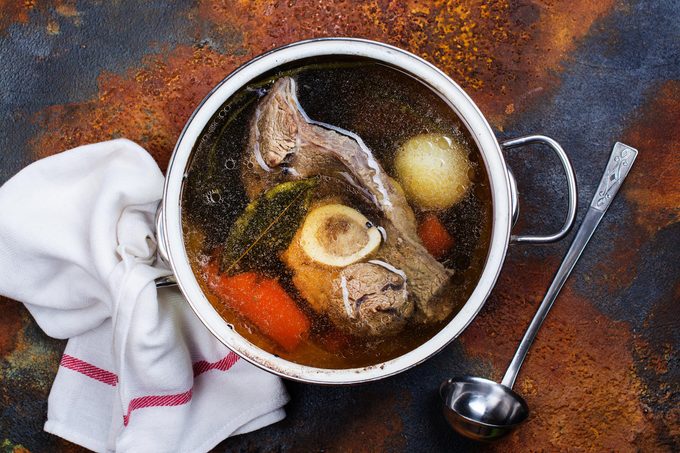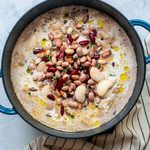Does the Bone Broth Diet Work for Weight Loss?
You've heard all the hype, now find out the truth about sipping your way to a slimmer waist.

What is bone broth?
You’re already familiar with broth and stock — now it’s time to meet their thicker and more potent big brother, bone broth. So what’s the real difference between stock and broth? Jessica DeLuise, MHS, PA-C, CCMS, founder of Eat Your Way to Wellness, says that broth is made from meat flesh, veggies, and aromatics; stock is made from bones, fresh veggies, and aromatics simmered for less than 18 hours; and bone broth is like stock, but simmered for 18 to 24 hours or longer to break down the collagen and minerals in the bone and allow them to seep into the broth.
How long has bone broth been around?
People have been making and drinking bone broth for many, many years. “The Chinese started using it over 2,500 years ago, while 12th-century Egyptian physicians prescribed it as a remedy for colds and asthma,” says food scientist Bryon Yang, PhD, president of Nutra Food Ingredients. “With modern science, we have finally been able to understand what makes bone broth so special — it’s the nutrients it carries.” He says bone broth is filled with vitamins, calcium, magnesium, phosphorous, iron, amino acids (the building blocks of protein), and collagen (the most abundant protein in your body, found in connective tissue, ligaments, hair, nails, and skin).
What is the bone broth diet?
By now, you’ve probably been inundated with info from friends and celebrities like Gwyneth Paltrow, who swear by this diet — but, honestly, what’s all the hype about bone broth? While it has been around for centuries, it’s having a modern-day moment, thanks to the bone broth diet. Created by Kellyann Petrucci, MS, ND, a naturopathic physician and weight-loss specialist who wrote the book Bone Broth Diet, this 21-day diet claims to harness the ancient power of collagen and bone broth to promote gut health, reduce chronic inflammation, reverse the signs of aging, regain energy, eliminate headaches, and support autoimmune diseases.
What do you eat on the bone broth diet?
“Bone broth is a traditional food that involves the slow simmering of bones and veggies for an extended period of time, making it a rich source of collagen, gelatin, and amino acids and minerals,” says Samantha Presicci, MCN, RD, LD, CPT, who is the lead registered dietician at Snap Kitchen. The 21-day plan popularized by Dr. Petrucci involves eating Paleo five days a week (which means eating animal protein, fruits, veggies, nuts, seeds, and healthy fats while avoiding grains, dairy, sugar, and artificial sweeteners, processed foods, and legumes) and then fasting with bone broth the other two days. On the days that you eat Paleo you replace your snacks with bone broth; on the fasting days, you replace all meals with bone broth. If you need a little reassurance, read on to learn more about the paleo diet and find out if it’s right for you.
How does the bone broth diet promote weight loss?
“I like the bone broth diet for a few reasons,” says DeLuise. “Bone broth is high in protein, collagen, and minerals, which can support healthy tissues, satiety, and gut healing. Plus, while eating Paleo, you’re removing the majority of potential foods that could cause bloating or weight gain, such as dairy, wheat, and beans.” By sipping on bone broth between meals, she says dieters may feel less of an urge to grab a processed, sugar-laden snack. And since it’s mostly water, it’s an easy and delicious way to hydrate the body. All of these properties work together to help lower overall calorie intake. Finally, the fasting days with bone broth align with many beliefs of fasting and intermittent fasting for wellness, which have been associated with weight loss and improving insulin resistance.
What kind of weight loss can people expect?
Everyone is different, so there is no set amount. “It’s possible someone could probably lose between five to ten pounds in 21 days, with much of that being water weight,” says Presicci, “but I definitely do not recommend or encourage attempting quick weight loss. Since this diet is only meant for 21 days, people may treat it as a crash diet and miss the opportunity to use it as a reset for gut, hormone, and overall health.” And while you’re at it, consider adding one these best gym machines for weight loss into your new routine.
Do the experts recommend the bone broth diet for weight loss?
Yes…and no. Dr. Yang says it’s low in calories, which increases your ability to burn excess calories and lose weight, while the high protein content (about 8 to 10 grams of protein per 8 ounces) also helps build muscle and makes your body feel fuller for longer. “The longer an individual feels full, the lower their food cravings will be throughout the day,” he says. “Less food equals less calorie intake. If an individual combines the diet with exercise three to four times a week, they will have a recipe for weight-loss success.”
Conversely, Rachel Fine, RD, owner of To The Pointe Nutrition, says that the bone broth diet is a “dangerously restrictive diet” and calls it “an unhealthy, short-term fix for weight loss, which will further result in the vulnerability to increased weight gain later on.” She goes on to say that the long-term negative effects of a restricted diet outweigh potential short-term benefits because restricting carbs causes the body to release specific hormones to counter the restriction, promoting increased cravings. Essentially, it could backfire.
What are the additional benefits beyond weight loss?
“There are numerous benefits to eating a paleo diet and drinking bone broth, including decreased inflammation, better sleep, improved skin health, normal blood sugars, improved gut health, and more,” says Presicci. “The key with both of these approaches is to be consistent—it won’t help to follow a plan for 21 days if you’re not planning to continue those habits long-term. The benefits of Paleo and of bone broth are only going to be seen if both habits are practiced consistently.” If you aren’t familiar with the importance of a healthy gut, read up on these 10 ways to a better microbiome.
Are there any risks to this diet?
Given the disparity of opinions between registered dietitians regarding the bone broth diet, it’s wise to check with your personal dietitian or health practitioner to figure out if it’s a good fit for you—particularly if you are on medication, suffer from hypoglycemia, or are pregnant or breastfeeding. “Especially for someone new to healthy eating, I’d recommend avoiding the fasting days and instead incorporating bone broth into their day of eating,” advises Presicci. “Bone broth can help decrease water retention and inflammation, even if you don’t change much else in your diet.” If you’re determined to try fasting, start the process with this intermittent fasting guide.
Are there any alternatives if you don’t want to commit to 21 days?
If you’re unsure about jumping headfirst into a three-week program, perhaps a one-week plan might be more palatable. Meredith Cochran, who has a degree in cellular molecular biology and a background in traditional Chinese medicine, and is co-founder and CEO of The Osso Good Co., wrote the book The 7-Day Bone Broth Diet Plan. Her version is all about rebooting your gut and setting you on a path to a better-feeling you with healthier eating habits. “The main idea of this diet is simple: Consume two servings of bone broth per day, plus whole foods as needed to improve your path to better gut health,” she explains. “This means eating only pastured and grass-fed proteins, good saturated fats, like avocado, coconut oil, and ghee, and organic vegetables. Avoid processed foods, alcohol, dairy, grains, and sugar because they cause inflammation in your gut. Bone broth is naturally anti-inflammatory and improves digestion, allowing your gut to do a mini reset.”
Where do you find bone broth?
You can easily make it in your own kitchen or buy store-bought versions. If making at home, Presicci says to choose pasture-raised bones and filtered water for your recipe. If you buy bone broth from the store, make sure you’re buying bone broth and not stock. Bone broth has been slow cooked for 24+ hours, leaching important nutrients from the bones, whereas stock is cooked for a lot less time and as a result, it has less collagen and gelatin.
Are all bone broths created equal?
As with most food products, there’s a big difference in quality between brands and packaging methods. Perishable bone broth, which requires refrigeration, has a shelf life of around one week or can be frozen for 6 to 12 months. If made the right way, perishable bone broth is thick and gelatinous with a Jello-like consistency when cold.” On the flip side, shelf-stable broth may seem more convenient, but the health benefits are diminished. When you shake them, you’ll notice a watery texture, unlike the thick and gelatinous texture that’s characteristic of a perishable bone broth when cold. “To make a shelf-stable bone broth, it must be heated to a very high temperature,” she continues. “This high temperature, even for a few seconds, often destroys the fragile gelatin, leaving behind a liquid similar to the texture of water.” So what you gain in portability and shelf life you may lose in health benefit.
The bone broth diet isn’t for everyone, but there are other ways to incorporate broth and its benefits into your diet. If you’re not interested in bone broth at all, these 21 Whole30 snacks you’ll actually want to eat might help add nutrients to your diet and aid in weight loss, too.




